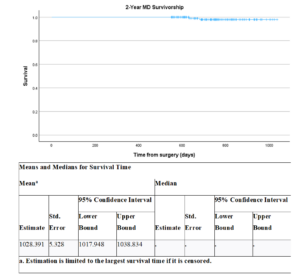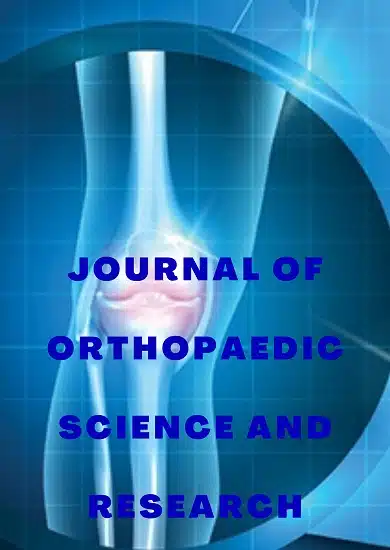Research Article | Vol. 6, Issue 1 | Journal of Orthopaedic Science and Research | Open Access |
Two-Year Clinical and Patient Reported Outcomes of a Kinematically Designed Cruciate Retaining Total Knee Arthroplasty with a Novel Liner Design
Zoe Alpert1, Farouk Khury1,2, Nicholas Sauder3, Alan Lam4, Greta Laudes1, Christopher Melnic3, Chad Krueger4, Ran Schwarzkopf1*
1Department of Orthopedic Surgery, NYU Langone Health, New York, New York, USA
2Division of Orthopedic Surgery, Rambam Medical Center, The Ruth and Bruce Rappaport Faculty of Medicine, Haifa, Israel
3Department of Orthopaedic Surgery, Massachusetts General Hospital, Harvard Medical School, Boston, MA; Department of Orthopaedic Surgery, Newton-Wellesley Hospital, Newton, MA, USA
4Rothman Orthopaedic Institute at Thomas Jefferson University, Philadelphia, PA, USA
*Correspondence author: Ran Schwarzkopf, MD MSc, Department of Orthopedic Surgery, NYU Langone Health, NYU Langone Orthopedic Hospital 301 E 17th St New York, NY 10003, USA; Email: [email protected]
Citation: Alpert Z, et al. Two-Year Clinical and Patient Reported Outcomes of a Kinematically Designed Cruciate Retaining Total Knee Arthroplasty with a Novel Liner Design. J Ortho Sci Res. 2025;6(1):1-8.
Copyright© 2025 by Alpert Z, et al. All rights reserved. This is an open access article distributed under the terms of the Creative Commons Attribution License, which permits unrestricted use, distribution, and reproduction in any medium, provided the original author and source are credited.
| Received 04 February, 2025 | Accepted 21 February, 2025 | Published 28 February, 2025 |
Abstract
Introduction: Implants designed for Cruciate Retaining (CR) Total Knee Arthroplasty (TKA) are a relatively novel development. Medial dished tibial inserts have a more constraining medial side, which allows for similar kinematics and function to a native knee. The purpose of this study was to analyze clinical and patient-reported outcomes following CR TKA using a kinematically-designed system.
Methods: A multicenter retrospective review of 139 patients who underwent primary elective TKA utilizing a novel kinematically designed CR Knee System (JOURNEY™ II CR Medial Dished; Smith and Nephew, Memphis, TN) between February 2022 and July 2023 was conducted. Patients from three different institutions with at least two years of follow-up were included in this study. Demographic information, clinical outcomes and Patient-Reported Outcome Measures (PROMs) were collected and analyzed.
Results: Our study included 139 TKA patients. The average age was 66.1 years and 37.4% of patients were male and 62.6% were female. The primary diagnosis for all patients was primary Osteoarthritis (OA). The average length of stay was 1.3 days and 95% of patients were discharged home. The remaining 5% went to a Skilled Nursing Facility (SNF). Within 90 days of surgery, two patients visited the Emergency Department (1.4%) and six patients were readmitted (4.3%). The two-year implant survivorship rate was 98.6%, with two patients undergoing revisions: one for Periprosthetic Joint Infection (PJI) and one for wound dehiscence. The average increase in KOOS, JR scores from preoperative to two-years postoperative (25.9) reached the minimal clinically important difference (16.2 to 35.6).
Conclusion: The high survivorship rate and significant increase in PROMs indicates that a medially constrained, CR tibial insert is a safe and effective option for use in TKA. Further research is warranted in studying long-term survivorship.
Keywords: Total Knee Arthroplasty; Cruciate Retaining; Osteoarthritis; Periprosthetic Joint Infection
Introduction
With approximately 719,000 procedures projected to be performed annually by 2040, Total Knee Arthroplasty (TKA) is considered one of the most common surgeries performed in the U.S. [1]. Despite the rising number of TKA, only 81% of the operated patients are satisfied after their procedure. That leaves 19% very dissatisfied, dissatisfied or neutral. The pain relief satisfaction varies from 72% to 85% depending on the activity in question [2,3]. These numbers indicate room for improvement of TKA, to better alleviate pain and restore functionality of the knee.
In recent years, new implant techniques and models have emerged, all striving to improve long-term outcomes, joint function and patient satisfaction. While currently the Cruciate-Retaining (CR) and Posterior-Stabilizing (PS) are the most commonly used implants, several implant designs that guide the motion of the medial compartment have been increasing in popularity. These implants attempt to replicate the physiological kinematics of the knee joint by relying on the Medial Pivot (MP) motion of the medial compartment and reduced lateral congruence [4]. An alteration of these concepts is the newly developed Medial Dished (MD) insert which relies on an asymmetrically designed insert with more medial congruency to promote sufficient joint rotation rather than fully adopting a medial pivot design. These designs are intended to closely mimic the natural geometry and kinematics of the knee joint and are theorized to lead to enhanced contact stresses, decreased polyethylene wear and a more accurate restoration of physiological knee kinematics [5-7].
The goal of this study is to evaluate clinical outcomes and implant survivorship of a kinematically aligned TKA with a novel tibial medial dished liner design with a follow-up period of at least two years. Specifically, we aim to assess the incidence of complications and revisions, Patient-Reported Outcome Measures (PROMs) and the overall survivorship of the MD design.
Methods
Study Design
A retrospective study of 139 patients from three institutions was done to evaluate the clinical and satisfactory outcomes of a kinematically-aligned TKA with a novel medial dished tibial insert design (JOURNEY™ II CR Medial Dished; Smith and Nephew, Memphis, TN). Institutional Review Board (IRB) approval was received before initiating any investigation. Patients that underwent primary, elective TKA using the above system between February 2022 and July 2023 with at least two years of follow-up were included in the study. This resulted in our final cohort of 139 knees having the medial dish tibial insert utilized in their CR TKA articulation.
Data Collection and Measures
To evaluate this novel system, demographic, intraoperative, implant information, short-and mid-term clinical outcomes and PROMs were recorded. All information was obtained through retrospective chart review of patients’ Electronic Medical Records (EMR) (EPIC, Verona, Wisconsin).
The demographic variables were sex, age, race, smoking status, insurance status, American Society of Anesthesiology (ASA) score, Body Mass Index (BMI), Charlson Comorbidity Index (CCI) and primary diagnosis. The intraoperative and implant variables collected included operative time, type of anesthesia, laterality, patellar resurfacing/fixation and bearing surface. The short-term clinical outcomes included Length Of Stay (LOS), discharge disposition, 90-day Emergency Department (ED) visits and 90-day readmissions. The long-term clinical outcomes measured were incidence and indication of revisions. Knee injury and Osteoarthritis Outcome Score for Joint Replacement (KOOS, JR) scores were evaluated preoperatively, six months postoperatively and two years postoperatively.
Data Analyses
Excel software (Microsoft Corporation, Richmond, WA) and Statistical Package for the Social Sciences (SPSS) (Version 28; IBM Corporation, Armonk, NY) were utilized to organize and analyse data. Statistical significance was reached at P-values below 0.05. The frequencies of nominal and ordinal variables were calculated as a percentage. The means, ranges and standard deviations were calculated for ratio and interval variables. A Kaplan-Meier Survivorship analysis was done to assess implant survivability up to two years following primary TKA. The minimum clinical significance was calculated using a distribution-based method, where the range was plus or minus one-half of a standard deviation from the mean [8].
Results
The primary diagnosis for all 139 TKAs was primary osteoarthritis. The average patient age was 66.1 years, with the youngest patient being 39 years old and the oldest being 85. The cohort was slightly more than half female patients (n = 87, 62.6%). The remaining 37.4% were male (n = 52). There were 102 White patients (73.4%), one Latino or Hispanic patient (0.7%), 22 Black or African American patients (15.8%), four Asian patients (2.9%) and 10 patients who identified as “Other” (7.2%). Very few patients were current smokers (n = 3, 2.2%). There were 63 former smokers (45.3%) and 73 patients who were never smokers (52.5%). Most patients had an ASA score of two or three (n = 93, 66.9%; n = 41, 29.5%, respectively). There were four patients with an ASA score of one (2.9%) and one patient with an ASA score of four (0.7%). The average BMI was 31.1, ranging from 19.31 to 51.02. The mean CCI score was 3.3, with scores ranging from 0 to 13. The average time to follow-up was 742.5 days, with the longest follow-up being 1036 days, or nearly three years (Table 1).
The average operative time was 97.3 minutes, with the shortest surgery being 74 minutes and the longest being 196. Most patients received spinal/regional/block anesthesia (n = 135, 97.1%). The remaining four patients went under general anesthesia (2.9%). There were nearly equal right and left TKAs performed (n = 71, 51.1%; n = 67, 48.2%, respectively). One patient underwent simultaneous bilateral TKA (0.7%) (Table 2).
Patella resurfacing data was collected as well. Of these patients, 108 had cemented fixation (77.7%) and 12 were press-fit (8.6%). The remaining 19 patients did not have a resurfaced patella (13.7%). Nearly three-quarters of patients had a cobalt chrome-on-polyethylene bearing surface (n = 100, 71.9%). The remaining 28.1% of patients had an oxidized zirconium-on-polyethylene bearing surface (n = 39) (Table 2).
We measured both short- and mid-term outcomes (Table 3, Table 4). The average length of stay was 1.3 days, with the shortest stay being 0.3 days and the longest being just over a week at 7.2 days. The majority of patients were discharged home (n = 132, 95.0%). All seven patients that were discharged to a facility went to SNF (5.0%). There were two patients that visited the ED within 90 days of surgery (1.4%). The readmission rate was slightly higher (4.3%), as six patients were readmitted within 90 days of surgery. Two patients were admitted for manipulation under anesthesia and one for deep vein thrombosis. The remaining three patients were admitted for syncope, psychiatric reasons and angiodysplasia of stomach and duodenum with bleeding. There was a high implant survival rate of 98.6%, with just two patients undergoing a revision surgery within two years, as shown in the Kaplan-Meier graph (Fig. 1, Table 4). One patient was indicated for surgery due to PJI and the other for wound dehiscence.
KOOS, JR scores were recorded preoperatively, at six months and at two years (Table 5). The averages for these time periods were 46.2, 61.8 and 73.3, respectively. The change in this score from the preoperative period was also calculated. At six months, the average increase in KOOS, JR was 17.8 points and at two years, it was 25.9 points. (P<0.001 for both). Using a distribution-based approach, the minimum clinically significant difference was calculated to be between 9.5 and 26.2 six months postoperatively and between 16.2 and 35.6 two years postoperatively. The average changes in KOOS, JR at each time point fell into their respective ranges. These results showed both statistical and clinical significance.
Knees (n = 139) | |
Sex, n (%) | |
Male | 52 (37.4) |
Female | 87 (62.6) |
Age (yr) [range] | 66.1 [39 to 85] |
Race, n (%) | |
White | 102 (73.4) |
Latino or Hispanic | 1 (0.7) |
Black or African American | 22 (15.8) |
Asian | 4 (2.9) |
Other | 10 (7.2) |
Smoking status, n (%) | |
Current | 3 (2.2) |
Former | 63 (45.3) |
Never | 73 (52.5) |
ASA score, n (%) | |
1 | 4 (2.9) |
2 | 93 (66.9) |
3 | 41 (29.5) |
4 | 1 (0.7) |
BMI (kg/m2) [range] | 31.1 [19.31 to 51.02] |
CCI | 3.3 [0 to 13] |
Primary diagnosis, n (%) | |
Primary OA | 139 (100) |
Post-Traumatic OA | 0 |
Time to follow-up (days) (SD) | 742.5 (123.3) |
ASA: American Society of Anesthesiologists; BMI: Body Mass Index; CCI: Charlson Comorbidity Index; OA: Osteoarthritis; RA: Rheumatoid Arthritis | |
Table 1: Patient demographics.
Knees (n = 139) | |
Operative time (min) [range] | 97.3 [74-196] |
Anesthesia, n (%) | |
General | 4 (2.9) |
Spinal/Regional/Block Laterality, n (%) · Right · Left · Bilateral Patellar Resurfacing/Fixation, n (%) · Cemented · Press Fit (Cementless) · Non-Resurfaced Bearing Surface, n (%) · Oxidized Zirconium-on-Polyethylene · Cobalt Chrome-on-Polyethylene | 135 (97.1) 71 (51.1) 67 (48.2) 1 (0.7) 108 (77.7) 12 (8.6) 19 (13.7) 39 (28.1) 100 (71.9) |
Table 2: Intraoperative and implant variables.
Knees (n = 139) | |
Mean LOS (days) [range] | 1.3 [0.3 to 7.2] |
Discharge Disposition, n (%) | |
Home | 132 (95.0) |
SNF | 7 (5.0) |
ARF | 0 |
90-Day ED Visits, n (%) | 2 (1.4) |
90-Day Readmissions, n (%) | 6 (4.3) |
Angiodysplasia of stomach and duodenum with bleeding | 1 (0.7) |
MUA | 2 (1.4) |
DVT | 1 (0.7) |
Syncope | 1 (0.7) |
Psychiatric | 1 (0.7) |
LOS: Lengths of hospital Stay; SNF: Skilled Nursing Facility; ARF: Acute Rehabilitation Facility; ED: Emergency Department; PJI: Peri-prosthetic Joint Infection. | |
Table 3: Short-Term clinical outcomes.
Knees (n = 139) | |
Revisions, n (%) | 2 (1.4) |
PJI (Explant with spacer) | 1 |
Wound Dehiscence (I&D with poly exchange) | 1 |
PJI: Peri-prosthetic Joint Infection | |
Table 4: Mid-Term clinical outcomes.
Knees (n = 139) | P-value | Minimum Clinical Significance Range | |
Mean KOOS, JR (SD) | |||
Preoperative | 46.2 (16.5) | ||
6 months | 61.8 (13.5) |
|
|
2 years | 73.3 (15.7) |
|
|
Δ Preop to 6 months | 17.8 (16.7) | <0.001 | 9.5 to 26.2 |
Δ Preop to 2 years | 25.9 (19.4) | <0.001 | 16.2 to 35.6 |
KOOS, JR: Knee injury and Osteoarthritis Outcome Score for Joint Replacement | |||
Table 5: Patient Reported outcome measures.

Figure 1: Kaplan-Meier survivorship analysis.
Discussion
The use of a medial dished tibial insert in CR TKA has demonstrated very good clinical outcomes and excellent implant survivorship within a two-year follow-up period. In terms of clinical outcomes, patients reported a vast improvement regarding pain management, activity endurance, functionality in sports and overall quality of life, as exhibited by the statistically and clinically significant improvement in KOOS, JR scores, both six months and two years postoperatively.
With the numbers of TKA rising annually, so is the need for better patient satisfaction and advancement in implant design. As is evident from previous clinical and radiographic studies as well as in-vivo analyses, the natural knee joint does not function in four-bar mechanism [4,9,10]. Rather, it is relatively constrained medially and is subject to rotational and translational movements in the less constrained lateral compartment. Based on these concepts, the physiological kinematics of the knee joint can be recreated using specific insert design; the medial dished insert incorporated asymmetrical design allows a more medial congruency facilitating natural joint motion with an excellent implant survivorship of 98.6% within two years of follow-up.
Regardless of the remarkable above 90% CR and PS implants’ 10-year overall survivorship rates, previous studies have shown that around 20% of the patients are dissatisfied with the outcomes [11-13]. Some studies have shown associations between certain demographic characteristics and patient satisfaction [13,14]. Another potential reason for patient dissatisfaction and decreased functional outcomes is due to the design of CR and PS prostheses, which are associated with abnormal kinematics such as paradoxical motion, mid-flexion instability and insufficient roll-back [15-17]. As a solution to these abnormalities, the Medial Stabilized (MS) concept was introduced in the 1990s, featuring a highly conforming medial compartment with reduced lateral congruency and developed to imitate the physiological asymmetric knee constraint [18]. A systemic review evaluated the mid-term outcomes of MS prosthesis, while comparing them to standard CR and PS articulations and demonstrated a 5-year comparable survivorship of around 96.5%, lower revision rates (2.4 vs. 13 and 7.2%, respectively) and improved stability [19-21]. Furthermore, patients who had an MS prosthesis demonstrated a considerable improvement in a variety of functional scores, specifically KOOS, JR, with an average of 39.3 increase between preoperative and 2-year follow-up [19]. Ultimately, this study concluded that the use of medially stabilized TKAs results in superior high-end function [19]. The medial dished insert investigated in our patient cohort has demonstrated similar high survivorship rates and significant changes in functional outcomes scores. However, even though some reported cases required revision surgery, none of these cases were due to implant longevity issues. Nonetheless, future studies should investigate the long-term survivorship rates, PROMs and complications to better compare the implant to its variants.
Perhaps the only tibial insert that exists in the current market and has a comparable effect to the medial dished design, is the Medial Congruent (MC) tibial insert. In contrast to the MS concept which uses a true ball-in-socket design, the MC inserts rely on highly congruent medial polyethylene insert for their stability. Similar to the MD insert’s philosophy, the MC design aims to restore not only stability but also native knee kinematics through a moderately confined medial compartment with most of the rolling and translation occurring in the lateral compartment of the knee [22]. Through the increased anterior lip height, more posterior swell point and modified sagittal congruency, the MC bearing design contributed to greater tibial external rotation than the CR design during the extension phase of the swing, known as the “screw-home mechanism” [23]. Frye, et al., investigated the outcomes of MC, CR and PS inserts and found that while the outcomes did not differ drastically, the MC design resulted in less pain and higher range of motion compared to the PS group, in addition to an increased FJS-12 score when measured against the CR group [23]. Another study reported better clinically assessed knee flexion range of motion in patients with a MC vs. PS insert design [24]. When comparing MC and CR inserts, the literature is somewhat inconsistent. In a double-blinded randomized controlled study comparing these two designs, the MC demonstrated closer physiological knee function as well as improved patient satisfaction, specifically in regaining confidence during daily activities [24]. Nonetheless, there are studies in which there was no significant difference found between the novel design and the standard CR concept. In a randomized study of 60 patients provided with either a CR or a MC insert, implant migration was analyzed and no significant variation in implant survivorship or PROMs between the two groups was detected [25].
One study comparing the PS design to the MC design found a significantly greater improvement in the PS group at three months postoperative as compared to the MC group [26], however, one year postoperatively, both groups had similar outcomes [26]. Regardless, a major disadvantage of the PS design is the accessory femoral box cut which can compromise bone stock and femoral condylar strength that may be needed in future revision cases [27].
Knee instability is one of the leading causes of early implant failure following primary TKA [29]. Therefore, the interplay between sufficient stability and optimal range of motion should be managed meticulously, as more constraint can increase the risk of early implant loosening and implant failure. A study investigating the outcomes of PS vs. MC implants reported that once adequate intra-operative stability was achieved, the lowest level of intra-articular constraint contributed to an improved range of motion at final follow-up visit [27]. Theoretically, increased congruency may improve natural knee kinematic stability. However, it is still debatable whether a high level of congruency can potentially increase the risk of early implant loosening. Future in vivo studies comparing the various degrees of constraints, congruency and stability in terms of clinical outcomes are required in order to study this.
Limitations
This study has several limitations that should be acknowledged. As a retrospective analysis, it includes a risk for bias such as selection bias and possible confounding variables missed during data collection. Moreover, with lack of a control group, the confounders may not have been controlled accurately. Due to the single center setting, the enrolled patients may be less heterogenic and may lead to a decrease in external validity, meaning that the results may not apply to all patient demographics. Furthermore, our sample size of 139 can be considered small, leading to decreased generalizability. However, our study is first to report this specific implant design which has not been studied previously.
Conclusion
This novel tibial insert is a promising and successful alternative to standard CR and PS implants, taking another step towards a more naturally working knee joint. In the future further studies are needed to assess the long-term outcomes of medially stabilizing implant designs regarding functionality, joint stability, kinematics and patient satisfaction.
Conflict of Interests
The authors declare that they have no conflict of interest in this paper.
Acknowledgments
Not applicable
Funding/Sponsorship
Not applicable
References
- Shichman I, Roof M, Askew N, Nherera L, Rozell JC, Seyler TM, et al. Projections and epidemiology of primary hip and knee arthroplasty in medicare patients to 2040-2060. JB and JS Open Access. 2023;8:e22.00112.
- Bourne RB, Chesworth BM, Davis AM, Mahomed NN, Charron KDJ. Patient satisfaction after total knee arthroplasty: Who is satisfied and who is not? Clinical Orthopaedics and Related Research. 2010;468:57-63.
- Gunaratne R, Pratt DN, Banda J, Fick DP, Khan RJK, Robertson BW. Patient dissatisfaction following total knee arthroplasty: A Systematic Review of the Literature. The Journal of Arthroplasty. 2017;32:3854-60.
- Hodgeson SM, Tatsuya Soeno, Mears SC, Stambough JB, Barnes CL, Stronach BM. The medial pivot design in total knee arthroplasty. Orthopedic Clinics of North America 2023;55:49-59.
- Hoskins W, Smith G, Spelman T, Vince KG. Medial pivot designs versus conventional bearing types in primary total knee arthroplasty: A systematic review and meta-analysis of randomized controlled Trials. JAAOS: Global Research and Reviews. 2022;6.
- Gray H, Guan S, Young T, Dowsey MM, Choong PF, Pandy MG. Comparison of posterior‐stabilized, cruciate‐retaining and medial‐stabilized knee implant motion during gait. J Orthopaedic Research®. 2020;38:1753-68.
- Budhiparama NC, Lumban‐Gaol I, Kiki Novito, Hidayat H, Federico De Meo, Cacciola G, et al. PCL retained is safe in medial pivot TKA-a prospective randomized trial. Knee Surgery, Sports Traumatology, Arthroscopy. 2023;31:5856-63.
- Lyman S, Lee YY, McLawhorn AS, Islam W, MacLean CH. What are the minimal and substantial improvements in the HOOS and KOOS and JR versions after total joint replacement?. Clinical Orthopaedics and Related Research®. 2018;476(12):2432-41.
- Osamu Tanifuji, Sato T, Kobayashi K, Mochizuki T, Koga Y, Hiroshi Yamagiwa, et al. Three-dimensional in vivo motion analysis of normal knees using single-plane fluoroscopy. Journal of Orthopaedic Science. 2011;16:710-8.
- Hamilton LD, Shelburne KB, Rullkoetter PJ, Barnes CL, Mannen EM. Kinematic performance of medial pivot total knee arthroplasty. The J Arthroplasty. 2023;39:1595-1601.e7.
- Argenson JN, Boisgard S, Parratte S, Descamps S, Bercovy M, Bonnevialle P, et al. Survival analysis of total knee arthroplasty at a minimum 10 years’ follow-up: a multicenter French nationwide study including 846 cases. Orthopaedics and Traumatology: Surgery and Research. 2013;99(4):385-90.
- Cacciola G, De Meo F, Cavaliere P. Mechanical and elution properties of G3 Low Viscosity bone cement loaded up to three antibiotics. J Orthopaedics. 2018;15:1004-7.
- Kim TK, Chang CB, Kang YG, Kim SJ, Seong SC. Causes and predictors of patient’s dissatisfaction after uncomplicated total knee arthroplasty. The Journal of Arthroplasty. 2009;24:263-71.
- Fritzsche H, Beyer F, Postler A, Lützner J. Different intraoperative kinematics, stability and range of motion between cruciate-substituting ultracongruent and posterior-stabilized total knee arthroplasty. Knee Surgery, Sports Traumatology, Arthroscopy. 2017;26:1465-70.
- Scott DF, Hellie AA. Mid-Flexion, Anteroposterior stability of total knee replacement implanted with kinematic alignment. Journal of Bone and Joint Surgery. 2022;105:9-19.
- Koshire S, Mohanty SS, Keny SA, Rai AK, Rathod TN, Kamble P. The influence of joint line restoration on functional outcome after primary total knee arthroplasty: A prospective study. J Clinical Orthopaedics and Trauma. 2022;34:102023.
- Kim J, Park JH, Park JH, Son D-W, Ahn JH. Prospective sequential comparison of femoral roll-back between cruciate-retaining and posterior-stabilized total knee arthroplasty using an intra-operative sensor. The Knee. 2022;39:253-60.
- Hossain F, Patel S, Rhee S-J, Haddad FS. Knee arthroplasty with a medially conforming ball-and-socket tibiofemoral articulation provides better function. Clinical Orthopaedics and Related Research. 2011;469:55-63.
- Cacciola G, Mancino F, Federico De Meo, Vincenzo Di Matteo, Sculco PK, Cavaliere P, et al. Mid-term survivorship and clinical outcomes of the medial stabilized systems in primary total knee arthroplasty: A systematic review. Journal of Orthopaedics. 2021;24:157-64.
- Spekenbrink-Spooren A, Van Steenbergen LN, Denissen GAW, Swierstra BA, Poolman RW, Nelissen RGHH. Higher mid-term revision rates of posterior stabilized compared with cruciate retaining total knee arthroplasties: 133,841 cemented arthroplasties for osteoarthritis in the Netherlands in 2007-2016. Acta Orthopaedica. 2018;89:640-5.
- Jones CW, Jacobs H, Shumborski S, Talbot S, Redgment A, Brighton R, et al. Sagittal stability and implant design affect patient reported outcomes after total knee arthroplasty. The J Arthroplasty. 2020;35:747-51.
- Indelli PF, Spinello P, Zepeda K, Campi S, Rossi SMP, Engl M, et al. Medially congruent total knee arthroplasty in valgus knee deformities yields satisfactory outcomes: a multicenter, international study. Knee Surgery, Sports Traumatology, Arthroscopy. 2021;31.
- Petersen ET, Rytter S, Koppens D, Dalsgaard J, Hansen TB, Andersen MS, et al. Medial congruent polyethylene design show different tibiofemoral kinematics and enhanced congruency compared to a standard symmetrical cruciate retaining design for total knee arthroplasty-an in-vivo randomized controlled study of gait using dynamic radiostereometry. Knee Surgery Sports Traumatology Arthroscopy. 2022;31:933-45.
- Frye BM, Patton C, Kinney JA, Murphy TR, Klein AE, Dietz MJ. A medial congruent polyethylene offers satisfactory early outcomes and patient satisfaction in total knee arthroplasty. Arthroplasty Today. 2021;7:243-9.e0.
- Pier Francesco Indelli, Risitano S, Hall KE, Leonardi E, Migliore E. Effect of polyethylene conformity on total knee arthroplasty early clinical outcomes. Knee Surgery, Sports Traumatology, Arthroscopy. 2018;27:1028-34.
- Christensson A, Tveit M, Kesteris U, Flivik G. Similar migration for medial congruent and cruciate-retaining tibial components in an anatomic TKA system: a randomized controlled trial of 60 patients followed with RSA for 2 years. Acta Orthopaedica. 2021 Oct 7:1-7.
- Lee WC, Foong CM, Khoo KM, Kwan YH, Kunnasegaran R. Faster improvement in outcome scores in posterior stabilised total knee arthroplasty compared to medial congruent system with posterior cruciate ligament retained. Musculoskeletal Surgery. 2024;108(1):87-92.
- Delasotta LA, Orozco F, Miller AG, Post Z, Ong A. Distal femoral fracture during primary total knee arthroplasty. J Orthopaedic Surgery. 2015;23(2):202-4.
- Wilson CJ, Theodoulou A, Damarell RA, Krishnan J. Knee instability as the primary cause of failure following Total Knee Arthroplasty (TKA): A systematic review on the patient, surgical and implant characteristics of revised TKA patients. The Knee. 2017;24:1271-81.
Author Info
Zoe Alpert1, Farouk Khury1,2, Nicholas Sauder3, Alan Lam4, Greta Laudes1, Christopher Melnic3, Chad Krueger4, Ran Schwarzkopf1*
1Department of Orthopedic Surgery, NYU Langone Health, New York, New York, USA
2Division of Orthopedic Surgery, Rambam Medical Center, The Ruth and Bruce Rappaport Faculty of Medicine, Haifa, Israel
3Department of Orthopaedic Surgery, Massachusetts General Hospital, Harvard Medical School, Boston, MA; Department of Orthopaedic Surgery, Newton-Wellesley Hospital, Newton, MA, USA
4Rothman Orthopaedic Institute at Thomas Jefferson University, Philadelphia, PA, USA
*Correspondence author: Ran Schwarzkopf, MD MSc, Department of Orthopedic Surgery, NYU Langone Health, NYU Langone Orthopedic Hospital 301 E 17th St New York, NY 10003, USA; Email: [email protected]
Copyright
Zoe Alpert1, Farouk Khury1,2, Nicholas Sauder3, Alan Lam4, Greta Laudes1, Christopher Melnic3, Chad Krueger4, Ran Schwarzkopf1*
1Department of Orthopedic Surgery, NYU Langone Health, New York, New York, USA
2Division of Orthopedic Surgery, Rambam Medical Center, The Ruth and Bruce Rappaport Faculty of Medicine, Haifa, Israel
3Department of Orthopaedic Surgery, Massachusetts General Hospital, Harvard Medical School, Boston, MA; Department of Orthopaedic Surgery, Newton-Wellesley Hospital, Newton, MA, USA
4Rothman Orthopaedic Institute at Thomas Jefferson University, Philadelphia, PA, USA
*Correspondence author: Ran Schwarzkopf, MD MSc, Department of Orthopedic Surgery, NYU Langone Health, NYU Langone Orthopedic Hospital 301 E 17th St New York, NY 10003, USA; Email: [email protected]
Copyright© 2025 by Alpert Z, et al. All rights reserved. This is an open access article distributed under the terms of the Creative Commons Attribution License, which permits unrestricted use, distribution, and reproduction in any medium, provided the original author and source are credited.
Citation
Citation: Alpert Z, et al. Two-Year Clinical and Patient Reported Outcomes of a Kinematically Designed Cruciate Retaining Total Knee Arthroplasty with a Novel Liner Design. J Ortho Sci Res. 2025;6(1):1-8.



